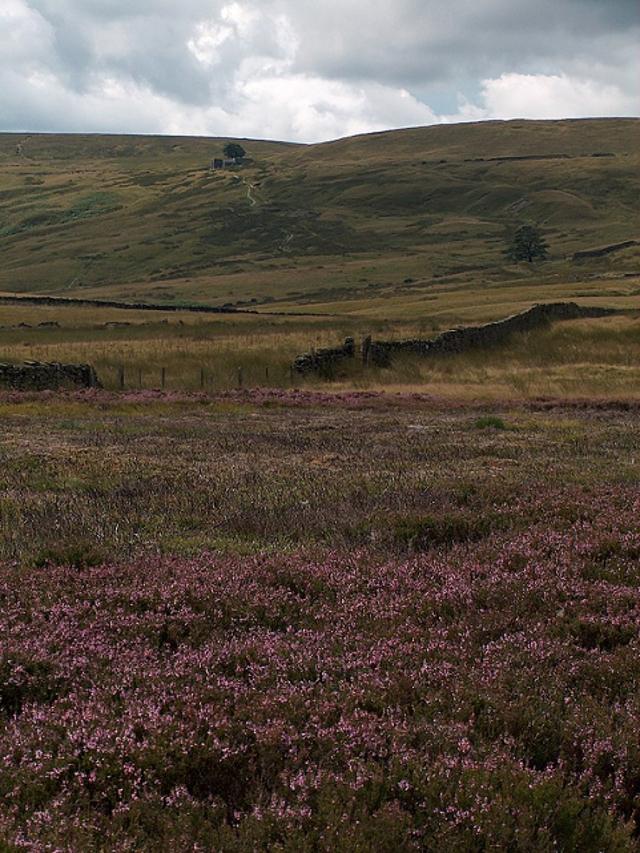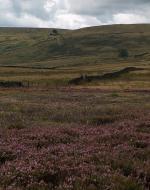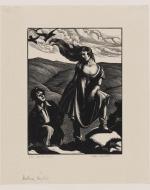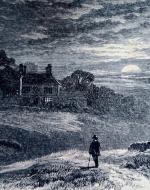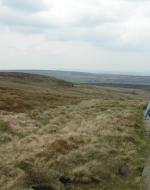Created by Kira Molnar on Thu, 11/17/2022 - 14:17
Description:
Located west of Bradford in West Yorkshire, England, lays a region of moorland in the south Pennine Hills. Harsh winds and stormy weather consume the moors, adding to its wild and unruly nature. Few trees grow there, and the few that do often reflect the rough and stunted way of the moors. Purple heather brings color to the otherwise muted grasslands, and bracken ferns and moss grow happily in this otherwise barren land. The moors are where the Brontë sisters grew up. All three sisters spent their childhood rambling about the moors, exploring the rugged landscape and the magic of the wilderness surrounding them. The sisters' love for the moors spread past their youthful memories of their carefree and imaginative childhood, as this wild and unruly landscape became an integral foundation for many of their later literary works. Today, these moors carry the legacy of the Brontë sisters' literary genius. The moors have become a popular tourist destination. People from all over the world come to walk the moors and visit the cultural landmarks that consumed much of the sisters' childhood and inspired their many memorable works.
Neil Theasby, Photograph of Haworth, Cross Roads and Stanbury, 2010, Wikimedia Commons. High up on a hill, past the bracken and the heather, sits Top Withens -- a now ruined farmhouse that is said to have been the inspiration for the Earnshaw family home in Emily Brontë's Wuthering Heights. The beauty of the moors is highlighted through the vibrant purple heather that foregrounds this photograph. Behind the heather, in the upper half of the photo, lies the more weather-beaten rugged rockiness of the moors. The photograph captures both the rugged and beautiful aspects of the moors.
Mick Manning and Brita Granström, Cover to The Brontë Sisters: Children of the Moors (2016), Franklin Watts, The Brontë Parsonage Museum. As the title of the book suggests, the Brontë sisters were deeply connected with the wild and windy moors which stretched for miles and miles through their homeland in Haworth in the Yorkshire Dales. A mystical place in need of exploring and adventure, the moorlands fed their ravenous imaginations and inspired many of their future works. Longtime collaborators and author-illustrators Mick Manning and Brita Granström have created numerous children's books including this book about the Brontës. Told from Charlotte Brontë's point of view, The Brontë Sisters: Children of the Moors retells the lives of the Brontë sisters, bringing their story to life with its rich text and vibrantly painted illustrations. They are called "children of the moors," and that is exactly what they were; by putting the three sisters clad in hiking boots walking the moors on the cover of the book, Manning and Granström foreground the importance of the moors and the impact that they had on the lives of the Brontë sisters.
Patrick Branwell Brontë, Portrait of Emily Brontë, 1834, The Victorian Web. Out of all the Brontë sisters, Emily was the most connected to the wild and unruly moorland, which inspired verses including "A Little While," written in 1838. Stanzas three, four, and five read as follows:
There is a spot, 'mid barren hills,
Where winter howls, and driving rain;
But, if the dreary tempest chills,
There is a light that warms again.
The house is old, the trees are bare,
Moonless above bends twilight's dome;
But what on earth is half so dear--
So longed for--as the hearth of home?
The mute bird sitting on the stone,
The dank moss dripping from the wall,
The thorn-trees gaunt, the walks o'ergrown,
I love them--how I love them all!
In the first stanza, with their torrential storms and tempest-howling winds, the moorlands appear wild and unyielding. The second stanza shows Emily's longing for her home filled with bare trees and moonless nights. The third stanza depicts the calm after the storm; the rain has stopped, and water drips from the waterlogged moss on the stone wall. A mute bird sits on the wall, and surrounding it are the gaunt thorn trees and scraggly overgrown paths of the moors. For Emily, there was no writing about home without writing about the moors -- for her, the two were one and the same.
Clare Leighton, Wood Engraving for Wuthering Heights (1847) by Emily Brontë, Duckworth illustrated edition, 1931, the estate of Clare Leighton, the British Library. The stormy tumultuous weather and strong winds present in both literature and reality are especially prominent in Emily Brontë's 1847 novel Wuthering Heights. This 1931 wood engraving by Clare Leighton perfectly captures Emily's term "wuthering," which Emily defines as "a significant provincial adjective, descriptive of the atmospheric tumult to which its station is exposed in stormy weather" (Wuthering Heights 4). This image depicts Catherine and Heathcliff standing together amongst the windy moors. Leighton captures the ever-present movement of the scene very well with the rolling hills in the background; the fast-moving clouds above, resembling gusts of wind; and Catherine's long hair, blowing freely next to the flying birds.
Edmund Morison Wimperis, "The View of Wildfell Hall", The Tenant of Wildfell Hall (1848) by Anne Brontë, Scribner, Welford & Armstrong illustrated edition, 1873. The moors in the novels of the Brontës help evoke the Gothic setting that is so prevalent in many of their literary works. In this 1873 engraving by Edmund Morison Wimperis, Wildfell Hall is tucked beneath a few weather beaten Scotch firs, isolated among the vast barren moorland. A light appears through one of the windows, while the rest of the great manor house remains dark and closed off. The hills on either side of Wildfell Hall fade into the background, further giving the impression that the manor house is completely isolated and separate from the rest of the world, secluded in the boundless moors.
Dave Dunford, Photograph of Pennine Way, Dick Delf Hill, Heading towards Top Withins, 2005, Wikimedia Commons. The moors are home to the Brontë sisters' literary legacy. The moors comprise part of the The Brontë Way, a long distance footpath that stretches 69 km (43 miles) through the Brontë Country in West Yorkshire. The route begins at Oakwell Hall, winding its way past many locations associated with the sisters and their novels, ending finally at Gawthorpe Hall. This map gives a more detailed look at the lay of the land and the many engrossing tourist attractions along the way. While the walk from the Brontë Parsonage Museum to Top Withens is only around 3.5 miles long, allowing for a nice afternoon hike through the moors (a hike that also passes the Brontë Waterfall), The Brontë Way gives more ambitious Brontë readers a more in depth view of the landscape where the sisters grew up. The route goes through Thornton, a small village just outside Bradford, known best as the birthplace of the Brontë siblings, and Haworth, where the Brontës moved to in 1820 when their father, Reverend Patrick Brontë, was appointed curate.
The "Brontë Country" of the West Yorkshire moors has been commodified as a way for people to connect to the sisters' literary genius. Today -- and beginning in the latter half of the Victorian era -- thousands of people travel from all around the world to make pilgrimages over the land that inspired so much of the sisters' work. In the image above, one such admirer of the Brontë sisters makes their way through the moors, following in the footsteps of the three brilliant women who brought such vivacious life to this barren landscape.

